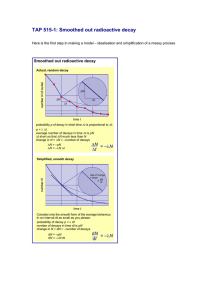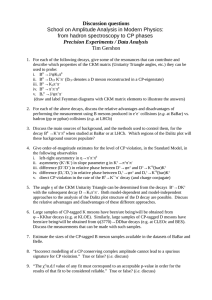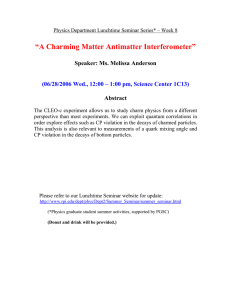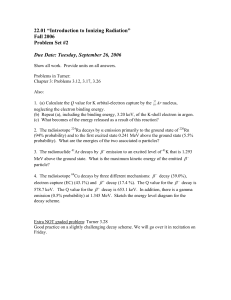Probing For New Physics In J/$\ Psi $ Decays
advertisement
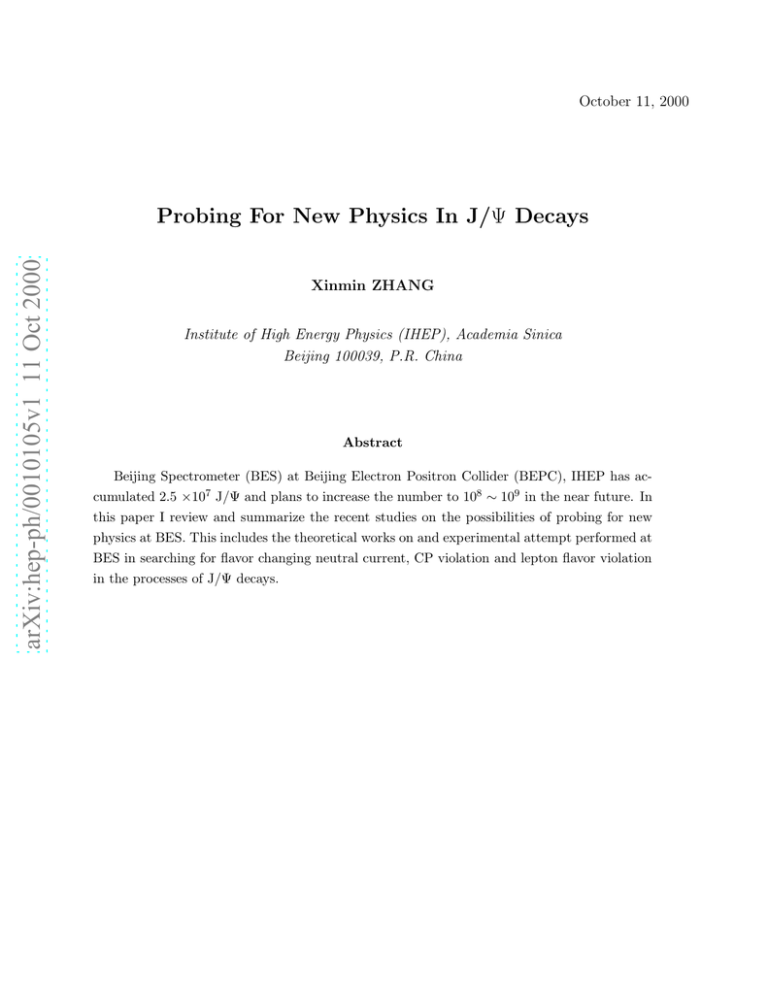
October 11, 2000 arXiv:hep-ph/0010105v1 11 Oct 2000 Probing For New Physics In J/Ψ Decays Xinmin ZHANG Institute of High Energy Physics (IHEP), Academia Sinica Beijing 100039, P.R. China Abstract Beijing Spectrometer (BES) at Beijing Electron Positron Collider (BEPC), IHEP has accumulated 2.5 ×107 J/Ψ and plans to increase the number to 108 ∼ 109 in the near future. In this paper I review and summarize the recent studies on the possibilities of probing for new physics at BES. This includes the theoretical works on and experimental attempt performed at BES in searching for flavor changing neutral current, CP violation and lepton flavor violation in the processes of J/Ψ decays. 1 Lepton flavor violating J/Ψ decays The J/Ψ rare decay processes J/Ψ → ¯ll′ ( l, l′ = τ, µ, e ) conserve total lepton number, but violate the individual lepton numbers. In the standard model the lepton flavor symmetries are conserved, but speculated to be violated in many extensions of the standard model, such as supersymmetric standard models, left-right symmetric models and models where electroweak symmetry is broken dynamically. Recent Super-Kamiokande experiment results indicate that neutrinos have non-vanishing masses, mix with each others and consequently that lepton flavor symmetry and/or lepton number symmetry are broken symmetries. In cosmology mystery of matter and antimatter asymmetry might be understood in terms of the brokendown of the lepton number symmetry together with the non-perturbative effects (Sphaleron) of the standard electroweak theory. There has been a lot of studies both theoretically and experimentally on testing the lepton flavor conservation law. At present we have various bounds listed in the particle data book from µ decays, τ and Z gauge boson decays[1]. With a large sample of J/Ψ, BES will be able to make an additional experimental searching for lepton flavor violation. To estimate the branch ratio of lepton flavor violating J/Ψ decays allowed by the current experimental data, Peccei, Wang and I[2] took a model-independent approach to new physics and introduced a four-fermion contact interaction 4π µ ¯ ′ c̄γ c lγµ l , Λ2 (1) where Λ is the new physics cutoff. This effective operator is forbidden in the standard model, however will be generated in theories where lepton flavor is not conserved, such as the minimal supersymmetric standard model with and/or without R parity, models with large extra dimension[3]. Therefore, any observed signal is a direct evidence for non- standard physics and will improve our understanding of flavor dynamics, especially in the lepton sector. There is no direct experimental limit on Λ in (1). However, at one-loop, attaching the neutral 2 gauge boson Z to the charm quark loop generates an effective coupling of Z to ¯ll′ . From the limits given in the particle data book on Br(Z → ¯ll′ )[1], we obtained the lower bounds on the branch ratio of the J/Ψ decay into leptons: Br(J/Ψ → τ + e− ) < 2.7 × 10−5 ; (2) Br(J/Ψ → τ + µ− ) < 4.9 × 10−5 ; (3) Br(J/Ψ → µ+ e− ) < 8.3 × 10−6 . (4) Recently Nussinov, Peccei and I[4] have examined “unitarity inspired” relations between twoand three-body lepton flavor violating decays and found that the existing strong bounds on µ → 3e and µ → eγγ severly constrain two-body lepton flavor violating decays of vector bosons [J/ψ, Υ, and Z o ] or pseudoscalars [π o , η] into µ± e∓ final states. However the bounds derived in Ref.[4] can be avoided if there is a kinematical suppression or as a result of some cancellations. Searching for lepton flavor violating decays of vector bosons such as J/Ψ remains a worthwhile experimental challenge. BES started one year ago[5] and has been working on an experiment of searching for J/Ψ → e∓ µ± . They will publish their result officially in the near future. 2 Single D meson production in J/Ψ decays Kinematically J/Ψ can not decay into D meson pairs, however it is able to decay into single D meson. In the standard model, these Cabbibo suppressed and/or favored weak decays have a typical branch ratio ∼ 10−8 or smaller, which is unobservable and because of which these processes serve as a probe of new physics. Recently Datta, O’Donnell, Pakvasa and I[6] have studied the possibility of searching for new flavor changing neutral current in the decay of J/Ψ. The purpose 3 of the study is to answer whether new physics can enhance sufficiently for the processes to be observable in the near future experiments. We first perform a model independent analysis, then examine the predictions of the models, such as TopColor models, minimal sypersymmetric standard model with R-parity violation and the two Higgs doublet model. We found that the branch ratio of J/Ψ → D/DXu could be as large as 10−5 [6]. Experimentally with BES-II data ∼ 8 × 106 J/Ψ, BES found no signal of single D production 0 in J/Ψ decays, and put limits on decay rates [7](at 90% C.L. ): Br(J/Ψ → D ρ0 ) ≤ 1.25 × Br(J/Ψ → Ds+ K − ) ≤ 2.8 × 10−5 , and Br(J/Ψ → D/DXu ) ≤ 1.7 × 10−4 . These are 10−5 ; preliminary results. Next year BES will have collected ∼ 5 × 107 J/Ψ. The upper limit on Br(J/Ψ → D/DXu ) is expected to be reduced to ∼ 3 × 10−5 , which is very close to the theoretical prediction. If there is still no signal found, it will put some constraints on models beyond the standard electroweak theory[6]. 3 CP violation in J/Ψ decays The origin of CP violation remains one of the outstanding problems in particle physics and cosmology. To pin down the sources and nature of CP violation in or beyond the Cabbibo-KabayashiMaskawa model, it would be necessary to consider different observations of CP violation in different channels from the K system, B sysytem, etc. The reaction of interest at BES is[8] e+ (p) + e− (−p) → J/Ψ → A(q− ) + B̄(q+ ) + X , (5) where A (B̄) are charged particles, for instance π ± in the processes of three or five pions decay of the J/Ψ, and p, q− and q+ are corresponding momentum in the laboratory frame. Define CP/T-odd operator O1 = ~p · ~q+ × ~q− . (6) |~p · ~q+ × ~q− | 4 If there exists CP violating interaction in J/Ψ decays, one would expect a non-vanishing expectation value of operator O1. Theoretically there could be many sources responsible for the CP violation in the process. One of them is the Chromo-dipole moment of the charm quark igc d2g cσµν γ5 λa cGµν a where dg has [mass]−1 dimension and the gc the strong interaction coupling constant. Consider the process of three pion decay of the J/Ψ. Its branch ratio is around 1.5%. With 108 ∼ 109 J/Ψ at BEPC II there will be around 106 ∼ 107 available for the analysis of CP violation. To estimate the experimental sensitivities to dg , let us consider only the statistical uncertainties. Neglecting the systematical uncertainties one expects to be able at BES to probe for dg as small as √ (1/ 106 ∼ 107 ) × (1/mc ) ≤ 10−17 cm. One can easily construct different kind of CP/T-odd operators of three momentum products (p, q− , q+ ) for the analysis of CP violation in J/Ψ decays. For instance, O2ij ∼ (~q+ − ~q− )i · (~q+ × ~q− )j + (i < − > j). (7) The initial electron and/or positron beams are not polarized at BEPC, otherwise one would be able to construct observables with the initial polarization vector ~σ , O3 ∼ ~σ · ~q− × ~q+ . (8) There has been proposal to measure CP violation in e+ e− → J/Ψ → ΛΛ̄. With a large sample of J/Ψ, one expects to probe for and put a strong bound on the electric dipole moment of Λ[9]. 4 Conclusion and comments In this paper I have concentrated on three kind of processes to probe for new physics in the decay of J/Ψ. There are some other rare decay modes which are interesting, but not reviewed. For instance, with a large sample of J/Ψ, it is possible and physically interesting to search for Goldstone or 5 Pseudo-Goldstone J, such as Axion in the process J/Ψ → γ + J . (9) Another example is the invisible decay of J/Ψ investigated by Chang, Lebedev and Ng[10] recently in models with extra Z-bosons, minimal sypersymmetric standard model with R-parity violation and decays into Goldstinos. The third example is provided by Bijnen and Maul[11], who recently have calculated in detail the branch ratio of J/Ψ decay into photon + missing energy in the popular theory these days with large extra dimension. They found that the branch ratio could be as large as 10−5 , which is measurable at BES. Before conclusion, we point out that even though we focus our discussions here on J/Ψ decays, it is quite easy to apply the studies in this paper for Ψ′ and Υ system[12]. ACKNOWLEDGMENTS I am grateful to my collaborators and colleagues for discussions. This work is supportted in part by the NSF of China. REFERENCES 1. Particle Data Group, C. Caso etal ., Europ. Phys. J, C3, 1 (1998). 2. ”Probing for lepton flavor violation in decays of charmonium and bottomonium systems”, R.D. Peccei, Jian-Xiong Wang and Xinmin Zhang, May 1998 Note (unpublished); Xinmin Zhang, invited talked given at the national conference on high energy physics, Chengde, China, April (1998). 3. For examples, see, Z.K. Silagadze, hep-ph/9907328, July (1999); T. Huang, Z. Lin and X. Zhang, hep-ph/0009353 (2000); Chan Hong-Mo et al, hep-ph/0006338, hep-ph/0007004, hepph/0008313/0008324. 6 4. S. Nussinov, R.D. Peccei and X. Zhang, hep-ph/0004153, April (2000). 5. G. Tong et al (Private communication). 6. A. Datta, P.J. O’Donnell, S. Pakvasa and X. Zhang, Phys. Rev. D60, 014011 (1999). 7. G. Rong et al (in preparation). 8. Xinmin Zhang, Jian-Xiong Wang, Jian-Pin Ma, Dongshen Du and Wu-Jun Huo (in preparation). 9. Xiao-Gang He, Jian-Pin Ma and McKellar, Phys. Rev. D49, 4548 (1994); Ye Yiun-Xiou and Ye Zheng-Yu (unpublished). 10. N. Chang, O. Lebedev and J.N. Ng, hep-ph/9806497, June (1998). 11. J. Bijnens and M. Maul, hep-ph/0006042, July (2000). 12. For example, it has been proposed to probe for CP violation in the process Ψ′ → J/Ψ+π + +π − , [ Xinmin Zhang, Dongshen Du, Pin Wang, A. Datta, Jian-Xiong Wang and Jian-Pin Ma, May 1998 note, unpublished; The experimental analysis started already(Jin Li and Zhi-Jin Guo, private communication)]. 7
